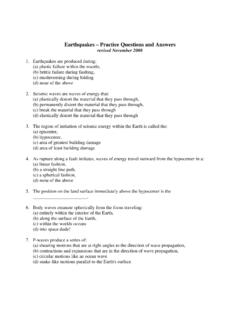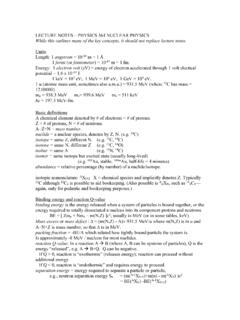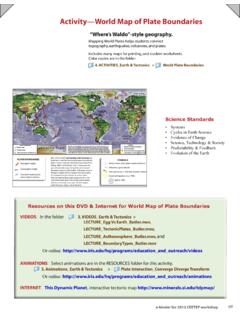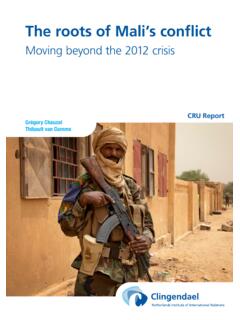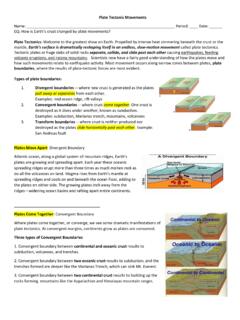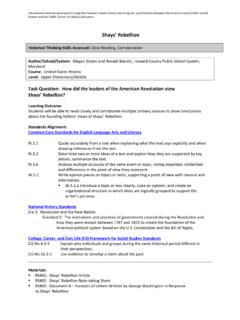Transcription of Plate Tectonics – Practice Questions and Answers Revised ...
1 Plate Tectonics Practice Questions and Answers Revised August 2007. 1. Please fill in the missing labels. 2. Please fill in the missing labels. 3. How many large plates form the outer shell of the earth? 4. What lies directly beneath the crust? 5. The upper mantle and crust make up what major tectonic feature of our planet? 6. What lies directly beneath the lithosphere and is around 200 km thick? 7. Continental crust is _____ than oceanic crust. 8. Oceanic crust is on average how thick? 9. A common rock type found within continental crust is called _____.
2 10. A common rock type found within oceanic crust is called _____. 11. According to Plate - tectonic theory where is new oceanic crust being formed? 12. Where are melts most likely to be produced by the adiabatic rise of mantle? 13. The San Andreas fault is a classical _____ boundary. 14. The East Pacific Rise and the Mid-Atlantic Ridge represent _____ boundaries. 15. What is subduction. 16. What is the likely cause of melting of mantle material along convergent margins? 17. The inner core is composed of _____ and _____.
3 18. What state is the inner core likely in? 19. The outer core is ____ dense than the mantle. 20. Most of the volume of our planet is composed of _____. 21. The Mohorovicic discontinuity separates the _____ from the _____. 22. What produces the Earth's magnetic field? 23. The asthenosphere is composed of _____ _____ mantle. 24. New lithosphere is produced at _____ _____. 25. Lithosphere is destroyed at _____ _____. 26. The mesosphere underlies the _____. 27. Please list the seven major lithospheric plates of our planet.
4 28. The trailing edge of the South American Plate lies where? 29. Silicate liquids that exist beneath the surface of the Earth are called _____. 30. Silicate liquids that have flowed out onto the Earth's surface or seabed are called _____. 31. Strato or composite volcanoes are typical of _____ _____. 32. Mt Shasta and Lassen formed in what kind of tectonic setting? 33. Beneath arcs at what depth does melting likely occur as a result of dehydration reactions? 34. What are the four driving forces behind Plate motion? 35.
5 Forearc basins occur between _____ _____ and _____. _____. 36. What kinds of Plate boundaries are found in California? 37. Which of the seven major lithospheric plates consists mostly of oceanic lithosphere? 38. The San Andreas fault separates the _____ Plate from the _____. _____ Plate . 39. Where is the Juan de Fuca Plate ? 40. Where is the Pacific Plate ? 41. On the following map please identify the 7 major lithospheric plates pointed to by the labels A, B, C, D, E, F, and G. 42. On the following illustration please identify the major components of a convergent margin pointed to by the labels A, B, C, D, E, F, and G.
6 43. On the following illustration please identify the major tectonic components of the western North American margin labeled (A), (B), (C), and (D). 44. On the following illustration please identify the features pointed to by labels A and B. 45. On the following illustration please identify the feature labeled A. 46. Which of the following, A or B, is representative of a fast-spreading center? 47. As plates move around on the globe they often times collide with each other. Examples include arc-arc and arc-continent collisions.
7 At least twice in the distant pass, all of the continents on planet Earth assembled into a supercontinent. The earliest supercontinent formed about to 750 ago, and the latest formed about 248 ago. What were the names of the former and latter supercontinents? 48. Please identify the features pointed to by the labels A, B, C, and D. What continent lies in the middle of the image? What oceans lie to the west and east of this continent? 49. The expanding Earth hypothesis was first formulated in the 1950s by S. Warren Carey, an Australian geologist.
8 Though Professor Carey recognized sea floor spreading and the idea that the continents had once been assembled into the supercontinent of Pangaea, he did not recognize an important element of the modern day Plate tectonic paradigm. What was that element and how does it weaken the expanding Earth hypothesis? Answers 1. (A) Moho (B) Mantle (C)Outer core (D) Inner core (E) Crust 2. (A) Lithosphere (B) Mid-ocean ridge or divergent margin (C) Trench or convergent margin (D) Asthenosphere (E) Mesosphere 3. 7. 4. mantle 5.
9 Lithosphere 6. asthenosphere 7. thicker 8. 7 km 9. granodiorite or granite 10. basalt 11. mid-oceanic ridges or divergent margins 12. mid-oceanic ridges and hot spots 13. transform 14. divergent 15. Subduction is when one lithospheric Plate descends beneath another. 16. As the subducted slab descends to about 100 km water and other volatiles are driven off. The water and volatiles move into the mantle of the over riding Plate , effectively lowering its melting temperature. 17. iron, nickel 18. It is either a solid or a very viscous liquid 19.
10 More 20. mantle 21. mantle, crust 22. The motion of the fluid outer core produces the Earth's magnetic field 23. partially melted 24. mid-ocean ridges or divergent margins 25. convergent margins 26. asthenosphere 27. North American, South American, African, Eurasian, Indian-Australian, Antarctic, Pacific 28. Extends from the east coast of the South American continent to the Mid-Atlantic Ridge 29. magma 30. lava 31. volcanic arcs 32. volcanic arc setting associated with a convergent margin . 33. About 100 km 34. convection, gravitational sliding, slab pull, ridge push 35.

